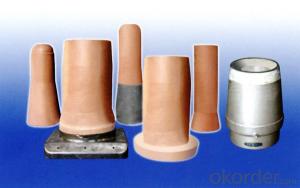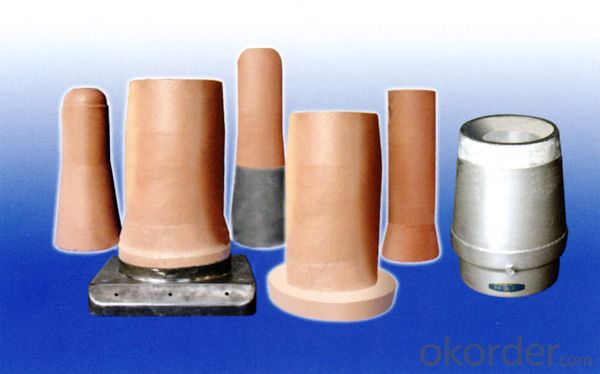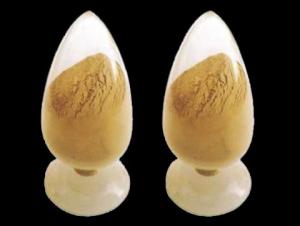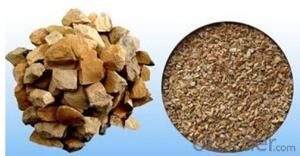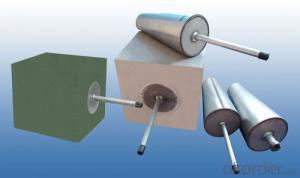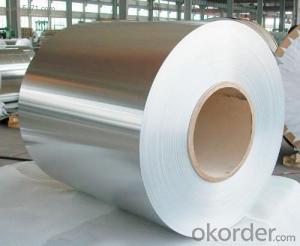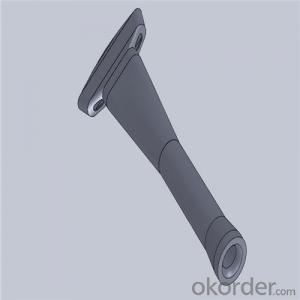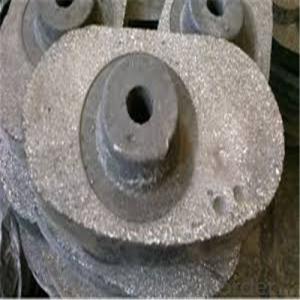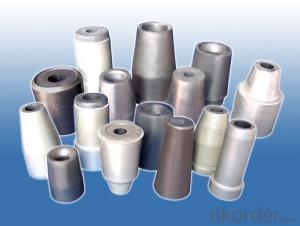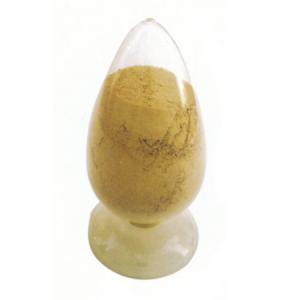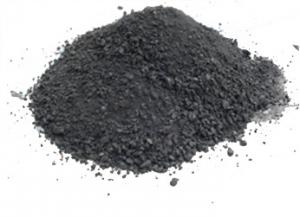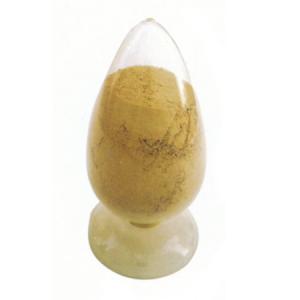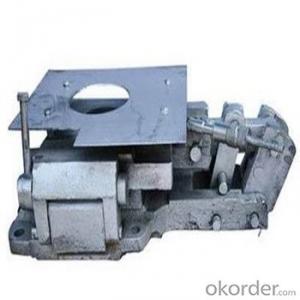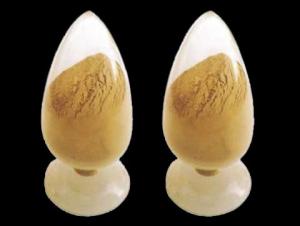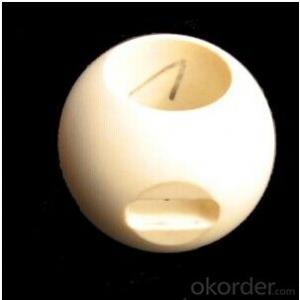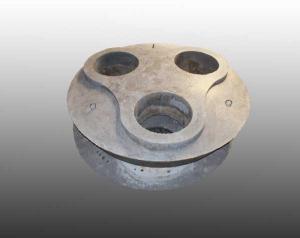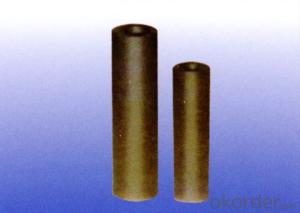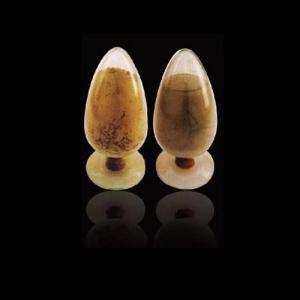Monolithic Refractories for Iron and Steel Industry - Refractory Tundish Upper Nozzle and Collect Nozzle
- Loading Port:
- Shanghai
- Payment Terms:
- TT OR LC
- Min Order Qty:
- 10 set
- Supply Capability:
- 50000 set/month
OKorder Service Pledge
OKorder Financial Service
You Might Also Like
Description:
Steelmaking tundish upper nozzle is an kind of quickchange nozzle,used together with tundish collect nozzle which produced by topcahse, with high purity zr 95% for steel continuous casting process
tundish nozzle is one kind of refractory alumina-zirconia-cartbon brick which are used for control the molten
steel in steel casting .we called is composite zirconia tundish nozzle
| Al2O3 % | Fe2O3 % | SiO2 % | TiO2 % | ZrO2 % | CaO % | MgO % | LOI % | Density g/cm³ | Proosity | fraclure strength Mpa | Application | |
| Body | 53.28 | 0.91 | 14.48 | 1.41 | 30.59 | 2.42 | 14.3 | 8.4 | general | |||
| Bowl struclure | 86.61 | 0.43 | 0.77 | 0.33 | 11.11 | 2.85 | 17.7 | 6.73 | general | |||
| Bowl struclure | 71.43 | 0.91 | 10.65 | 10.95 | 2.78 | 16.3 | 14.5 | Bowl struclure with serious corrosion | ||||
| Body | 63.15 | 1.51 | 6.83 | 0.87 | 3.25 | 22.13 | 2.6 | 16.24 | 8.67 | Inner part with serious corrosion | ||
| Liner | 64.1 | 0.81 | 4.06 | 4.94 | 0.12 | 0.32 | 22.5 | 2.4 | 16.7 | 7.2 | General anti-blocking | |
| Liner | 0.55 | 4.65 | 52 | 19.2 | 0.3 | 22.3 | 2.45 | 16.3 | 8.6 | High standard anti-blocking | ||
| Liner | 52.9 | 13.9 | 0.07 | 21 | 12.1 | 2.51 | 18.71 | 6 | Low carbon | |||
| Bowl struclure | 15.1 | 8.95 | 0.29 | 1.56 | 56.8 | 17.3 | 2.59 | 16.7 | 7.8 | Slag Containing |
Manufacturing and QC
1.Raw materials blending
Independent raw materials blending center to assurestrict control of materials quality.
2.Shaping
Isostatic pressing technoloty,with as 1000 tons of pressure to assure the homogenous bulk density of each product.
3.Machining
To assure the uniform shape,dimension and dimension tolerance of each product.
4.X-ray defect inspection
To assure all products supplied to our customers without any defect and to prevent the un-countable feconomic loss for our customers.
5.Physical and chemistry analysis
To assure all products meet the physical and chemistry characteristics.
6.Packaging
The world-class for packaging to assure the safety transportation.
- Q: What are the advantages of using insulating castables in the iron and steel industry?
- The advantages of using insulating castables in the iron and steel industry are numerous. Firstly, insulating castables have excellent thermal insulation properties, which help to reduce heat loss during the manufacturing process. This leads to increased energy efficiency and cost savings for the industry. Additionally, insulating castables have a low thermal conductivity, meaning they can withstand high temperatures without transferring excessive heat. This is crucial in the iron and steel industry, where temperatures can reach extremely high levels. By using insulating castables, the industry can ensure the longevity and durability of its equipment and structures. Furthermore, insulating castables have good resistance to thermal shock, meaning they can withstand rapid temperature changes without cracking or breaking. This is particularly beneficial in the iron and steel industry, where the heating and cooling processes are frequent and intense. Lastly, insulating castables have a low density, making them lightweight and easier to handle and install. This not only saves time and effort during installation but also reduces the structural load on equipment and structures. Overall, the use of insulating castables in the iron and steel industry offers advantages such as improved energy efficiency, enhanced durability, resistance to thermal shock, and ease of installation.
- Q: Can monolithic refractories be used in electric arc furnaces and induction furnaces?
- Yes, monolithic refractories can be used in both electric arc furnaces and induction furnaces. Monolithic refractories are versatile and can withstand the high temperatures and thermal shocks generated in these types of furnaces. They are often preferred due to their ease of installation, improved energy efficiency, and suitability for various furnace lining applications.
- Q: What are the main factors affecting the corrosion resistance of monolithic refractories?
- The corrosion resistance of monolithic refractories can be influenced by several important factors. To begin with, the refractory material's chemical composition plays a significant role. Refractories with high levels of silica (SiO2) generally exhibit greater resistance to corrosion due to silica's excellent resistance to acidic environments. Conversely, refractories with high alumina (Al2O3) content are more resistant to basic environments. Furthermore, the microstructure of the refractory material is crucial. A compact and well-bonded microstructure offers better corrosion resistance compared to materials with a porous structure. The presence of pores or cracks can allow corrosive substances to penetrate and attack the refractory, leading to its degradation. The temperature at which the refractory is exposed also affects its corrosion resistance. Higher temperatures can accelerate the corrosion process by promoting more aggressive chemical reactions. Additionally, thermal cycling, which involves subjecting the refractory to repeated heating and cooling, can create thermal stresses that contribute to material degradation. The type and concentration of corrosive agents present in the environment also impact the corrosion resistance of monolithic refractories. Different corrosive agents have varying levels of reactivity with refractory materials. For instance, acidic substances like sulfuric acid or hydrochloric acid can cause significant corrosion, whereas alkaline substances like calcium oxide can lead to a more gradual degradation. Moreover, mechanical stress applied to the refractory can influence its corrosion resistance. Mechanical vibrations, abrasion, or impact can weaken the refractory structure, making it more susceptible to corrosion. Lastly, the manufacturing and installation process can affect the corrosion resistance of monolithic refractories. Factors such as proper mixing, curing, and drying techniques can contribute to the development of a more resistant refractory structure. In conclusion, the corrosion resistance of monolithic refractories is influenced by factors including chemical composition, microstructure, temperature, presence of corrosive agents, mechanical stress, and manufacturing/installation processes. Understanding and managing these factors are crucial in selecting and maintaining the most suitable refractory material for a specific application.
- Q: What are the recommended drying procedures for monolithic refractories?
- The recommended drying procedures for monolithic refractories vary depending on the specific type and composition of the refractory material. However, there are some general guidelines that can be followed. Firstly, it is important to remove any excess moisture from the refractory material before drying. This can be done by storing the refractory in a dry environment or using a dehumidifier if necessary. Once the refractory is adequately dried, the drying process can begin. It is recommended to start with a low drying temperature to prevent cracking or spalling of the refractory. Gradually increase the temperature over time to allow for the gradual release of moisture. This can be done by using a controlled drying oven or furnace. The drying time will vary depending on the thickness and composition of the refractory. It is important to follow the manufacturer's guidelines for the specific refractory material being used, as they will provide the recommended drying time and temperature range. During the drying process, it is important to monitor the refractory closely for any signs of cracking or spalling. If any cracks or damage occur, the drying should be stopped immediately to prevent further damage. It may be necessary to repair or replace the damaged areas before continuing with the drying process. Once the refractory is fully dried, it is important to slowly cool it down to prevent thermal shock. This can be done by gradually reducing the temperature over time or allowing the refractory to cool naturally in a controlled environment. Overall, the recommended drying procedures for monolithic refractories involve gradually increasing the temperature over time, monitoring for any signs of damage, and slowly cooling down the refractory to prevent thermal shock. It is important to follow the manufacturer's guidelines and recommendations for the specific refractory material being used to ensure proper drying and optimal performance.
- Q: What are the key properties of shotcrete mixes used for monolithic refractory applications?
- The key properties of shotcrete mixes used for monolithic refractory applications include high strength, low porosity, high abrasion resistance, good thermal shock resistance, and excellent adhesion to the substrate. These properties ensure the durability and effectiveness of the shotcrete in withstanding high temperatures and harsh conditions in refractory applications.
- Q: How do monolithic refractories resist chemical attacks from molten metals and slag?
- Monolithic refractories resist chemical attacks from molten metals and slag due to their high chemical stability, which is achieved through the use of carefully selected raw materials and advanced manufacturing processes. These refractories are designed to have low porosity, which prevents the penetration of molten metals and slag into the material. Additionally, they possess high resistance to corrosion and erosion, even at high temperatures, allowing them to withstand the harsh chemical environments created by molten metals and slag.
- Q: How do monolithic refractories withstand chemical attack from molten metals and slag?
- Monolithic refractories withstand chemical attack from molten metals and slag due to their unique composition and properties. These refractories are made of a single, homogeneous material, which provides them with better resistance against chemical corrosion. Additionally, monolithic refractories are designed to have low porosity and high density, which limits the penetration of molten metals and slag into their structure. These materials also have high melting points, enabling them to withstand the extreme temperatures present in industrial processes. Overall, the combination of their composition, low porosity, high density, and high melting points makes monolithic refractories highly resistant to chemical attack from molten metals and slag.
- Q: How are monolithic refractories installed in iron and steel production processes?
- Monolithic refractories are installed in iron and steel production processes using various methods depending on the specific application and requirements. The installation process typically involves the following steps: 1. Surface Preparation: Before installing monolithic refractories, the surface where they will be applied must be properly prepared. This involves cleaning and removing any loose materials, dust, or contaminants from the substrate. 2. Mixing: Monolithic refractories consist of different materials such as aggregates, binders, and additives. These components are mixed in specific proportions to achieve the desired properties and consistency. The mixing process can be done manually or using mechanical mixers. 3. Application: There are different techniques for applying monolithic refractories, including gunning, casting, ramming, and troweling. The chosen method depends on factors such as the shape of the structure, accessibility, and required thickness. - Gunning: This method involves using a gunning machine to spray the refractory material onto the surface. It is commonly used to repair or patch existing linings or for rapid installation in areas that are difficult to access. - Casting: In casting, the refractory material is poured into molds or forms and left to set and harden. This method is suitable for creating complex shapes and large-sized components. - Ramming: Ramming involves manually or mechanically compacting the refractory material into a mold or form using a ramming tool. This technique is commonly used for lining induction furnaces, ladles, and other equipment. - Troweling: Troweling is a manual method where the refractory material is applied and smoothed using a trowel. It is often used for smaller repairs or touch-ups. 4. Curing: After the refractory material is applied, it needs to be cured to achieve its optimum strength and performance. Curing involves allowing the material to dry and harden at a controlled temperature and humidity for a specified period. This step is crucial to ensure the long-term durability and resistance of the monolithic refractory lining. Overall, the installation of monolithic refractories in iron and steel production processes requires careful preparation, proper mixing, and the appropriate application technique. It is essential to follow manufacturer guidelines and industry best practices to ensure a successful installation that meets the specific needs of the production process.
- Q: How do monolithic refractories resist corrosion and erosion in the iron and steel industry?
- Monolithic refractories in the iron and steel industry are designed to resist corrosion and erosion through a combination of their composition and application techniques. Firstly, the composition of monolithic refractories includes high-quality raw materials such as alumina, magnesia, and silica. These materials possess excellent resistance to corrosion and erosion. Alumina, for example, is highly resistant to chemical attack and can withstand high temperatures, making it ideal for protecting against the corrosive nature of the iron and steel industry. In addition to the choice of materials, the application techniques used in installing monolithic refractories also play a crucial role in their resistance to corrosion and erosion. Monolithic refractories are typically installed using various methods such as gunning, ramming, or casting. These techniques ensure a tight and seamless bond between the refractory and the steel structure, minimizing the chances of corrosion and erosion. Furthermore, monolithic refractories can be customized to suit the specific needs of different parts of the iron and steel industry. For example, areas exposed to molten metal require refractories with high thermal conductivity and excellent resistance to chemical attack. By tailoring the refractory to the specific application, it becomes more effective in resisting corrosion and erosion. Moreover, monolithic refractories are often designed with additives or binders that enhance their resistance to corrosion and erosion. These additives can provide additional protection against chemical attacks from molten metal or corrosive gases, making the refractory even more durable in harsh conditions. Overall, monolithic refractories resist corrosion and erosion in the iron and steel industry due to their composition, application techniques, customization, and the inclusion of additives. By combining these factors, monolithic refractories provide excellent protection to the steel structures, ensuring their longevity and efficiency in the challenging environments of the iron and steel industry.
- Q: What are the typical properties of monolithic refractories used in iron and steel industry?
- Monolithic refractories used in the iron and steel industry generally possess several key properties that make them suitable for the harsh operating conditions in these industries. Firstly, monolithic refractories have excellent thermal shock resistance. They can withstand rapid temperature changes without cracking or spalling, which is crucial in the iron and steel industry where the heating and cooling processes can be highly intense. Secondly, these refractories exhibit high refractoriness, meaning they can withstand extremely high temperatures without losing their strength or shape. This is essential in environments where temperatures can reach well above 1000 degrees Celsius. Additionally, monolithic refractories used in the iron and steel industry are known for their excellent corrosion resistance. They can resist the corrosive effects of molten metals, slags, and gases that are commonly encountered in these industrial processes. Furthermore, these refractories have good mechanical strength and abrasion resistance, allowing them to withstand the physical stresses and wear caused by handling and mechanical operations. Another important property of monolithic refractories is their ability to form strong bonds with the existing refractory lining. This ensures a secure and long-lasting installation, reducing the risk of failure and minimizing downtime for maintenance or repairs. Lastly, these refractories often have low porosity, which prevents the infiltration of molten metal or slag into the lining. This helps to maintain the integrity of the refractory structure and prolong its service life. Overall, the typical properties of monolithic refractories used in the iron and steel industry include thermal shock resistance, high refractoriness, corrosion resistance, mechanical strength, strong bonding, and low porosity. These properties collectively contribute to the efficient and reliable operation of iron and steel manufacturing processes.
Send your message to us
Monolithic Refractories for Iron and Steel Industry - Refractory Tundish Upper Nozzle and Collect Nozzle
- Loading Port:
- Shanghai
- Payment Terms:
- TT OR LC
- Min Order Qty:
- 10 set
- Supply Capability:
- 50000 set/month
OKorder Service Pledge
OKorder Financial Service
Similar products
Hot products
Hot Searches
Related keywords
